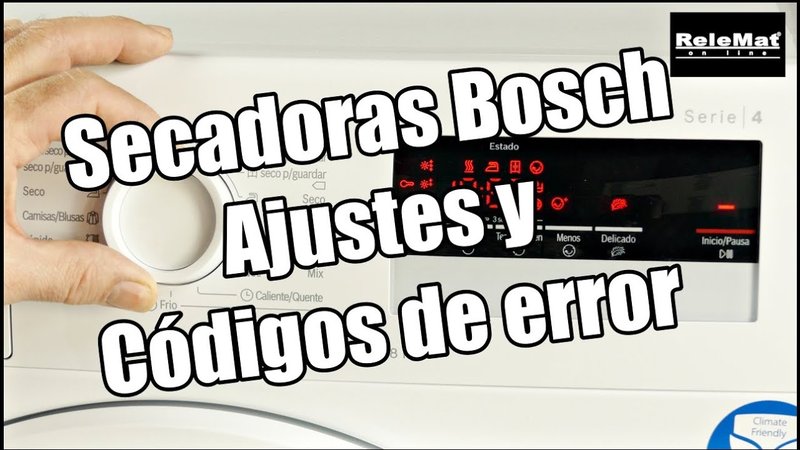
Let’s break it down: the “Error Code OE” typically indicates a problem with the dryer’s drainage system. Imagine the drainage system in your dryer like the plumbing under your sink. Just as a clog in the pipes could cause water to back up, any blockage or malfunction in your dryer’s drainage system can trigger this error code. The good news is that with regular maintenance and a few preventive steps, you can avoid running into this issue in the future.
Understanding Bosch Dryer Error Code OE
First, let’s talk about what causes this pesky error code. The “OE” error is usually linked to problems with water drainage. In a Bosch dryer, there’s a pump responsible for draining the condensate water. If this pump fails, or if there’s a blockage in the hose system, the water can’t drain properly. Think of it like trying to suck liquid through a straw with a piece of gum blocking the end – nothing’s getting through, right? In your dryer, this can lead to the machine halting and throwing up an error.
Another common cause can be an issue with the water outlet or the condenser itself. A dryer condenser that’s blocked with lint and dirt operates inefficiently, much like an air filter that hasn’t been changed in years. This can cause the dryer to work overtime, leading to overheating or drainage issues. It’s also worth noting that improperly installed drainage hoses or kinks in the hose can prevent water from exiting the dryer, thus causing the code to appear.
Now, here’s a little tip: Always be on the lookout for signs like unusual noises during operation, leaking water, or unusually damp clothes. These can be early indicators that something’s not right with your dryer’s drainage system. By catching these signs early, you can address minor issues before they escalate into more significant problems.
Routine Maintenance is Key
Just like keeping your car running smoothly requires regular oil changes, your Bosch dryer benefits from routine maintenance too. One of the best ways to prevent the “Error Code OE” is by keeping your dryer’s drainage and ventilation systems clear and functioning properly.
Start by checking the filter. A clogged filter can reduce airflow and lead to overheating, just like a blocked vacuum cleaner filter can cause the machine to overheat. Make it a habit to clean the lint filter after every drying cycle. It’s a small task, but it can make a big difference. Additionally, inspect the condenser unit if your model has one. Clean it periodically to ensure it’s free of lint and debris.
Next, take a look at the drainage hose. Make sure it’s not kinked or blocked. If the hose is incorrectly installed, it can cause water to back up and trigger the error. It’s similar to a garden hose — if it’s twisted, the water pressure drops and water barely flows out. Adjust the hose to ensure it’s in the right position and unclogged for optimal drainage.
Use High-Quality Detergents and Correct Settings
You might be thinking, “Does the detergent I use really matter?” Surprisingly, it does! Using high-quality detergents designed for your type of dryer can reduce the build-up of residues that might eventually clog the drainage system. Think of it like using premium gas in your car – it helps things run smoother and last longer.
Furthermore, understanding and using the correct dryer settings for different loads can also prevent excessive stress on the machine. Often, selecting the wrong drying cycle — like using a high heat setting for delicate items — can lead to unnecessary strain on your dryer. It’s like wearing running shoes to a formal event, not quite the right fit for the occasion, which may have unwanted consequences.
Lastly, avoid overloading the dryer. While it might be tempting to throw everything in at once, giving your dryer some breathing room allows it to function at its best. Overloading can impact airflow and lead to inefficient drying and increased wear on the machine components.
Invest in Professional Servicing
Let’s face it; while DIY fixes and regular maintenance are great, sometimes you need a pro to step in. Regular professional servicing can help detect and fix minor issues before they become major problems, much like regular dental check-ups keep your teeth healthy.
An experienced technician can thoroughly check your dryer, ensuring all parts, including the pump and hoses, are functioning correctly. They can perform a thorough deep-clean of areas you might not reach easily, which helps keep your dryer in top shape. Think of it like bringing your car in for a tune-up – professionals can spot issues that you might overlook.
Finally, professional servicing can also give you peace of mind, knowing that your appliance is in good hands. And as an extra perk, technicians often have tips and recommendations to help you keep your dryer running smoothly for years to come.
To wrap things up, preventing the “Error Code OE” in your Bosch dryer in the future boils down to understanding the causes, maintaining the machine regularly, using it correctly, and getting professional checks when needed. By following these steps, you’ll ensure your dryer serves you well, keeping your laundry days stress-free.